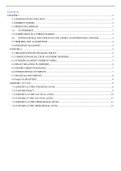Samenvatting
Summary Export Management: A European Perspective, ISBN: 9789001700324 International Supply Chain Management (FBE_2000SCM219-BE-IB)
- Instelling
- Hogeschool Van Amsterdam (HvA)
Summary for the course International Supply Chain Management 2, at the Hogeschool van Amsterdam. Summary of chapters 5,6,7 of the book Export Management a European Perspective Compressed.
[Meer zien]





